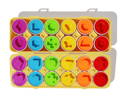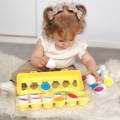Learning with Montessori Geometric Eggs: A Parent’s Guide
You've probably noticed by now how toddlers are like little sponges, soaking up every bit of information around them.
They're amazed by colors, intrigued by shapes, and absolutely love the challenge of putting things together (and taking them apart again, right?). It's this sheer curiosity that makes them so much fun and sometimes a little challenging.

That's where Montessori Geometric Eggs come into the picture. Think of them as the cool new toy that's more than just a toy – they're learning tools that align perfectly with the stuff our little ones are naturally drawn to.
So, before we jump into all the cool things about these eggs and how to make the most of them, let's chat about why they might just be the next favorite thing in your house.
What are Montessori Geometric Eggs?
You might be scratching your head, thinking, "Montessori Geometric Eggs? That's a mouthful! What are they?" Let's break it down, shall we?

Picture this: a set of 12 brilliantly designed geometric eggs nestled in what looks like an egg carton you'd find in your fridge. But here's the twist: instead of being fragile and ready-to-cook, these eggs are crafted from top-notch, BPA-free plastic.
Yep, they're made to endure the endless adventures our toddlers take them on!
Now, here comes the magic. Each egg isn't just a solid piece. They split in half, revealing colorful and uniquely shaped insides. The fun part? Kids get to match these halves, not just by their outer shape, but by the insides' shape and color! It's like a mini-puzzle, perfect for those tiny hands and sharp little minds.

And who's the star audience for these eggs? They're tailor-made for our little explorers aged one and up. As their curiosity about the world blossoms, Montessori Geometric Eggs are here to feed that curiosity and turn playtime into learning time.
The Montessori Philosophy Behind the Geometric Eggs
Ever heard of the Montessori method? If not, don't fret. In a nutshell, it's an educational approach that emphasizes hands-on, self-directed learning. Instead of traditional "sit down and listen" methods, Montessori lets kids learn by doing, exploring, and figuring things out on their own.

Now, where do the Montessori Geometric Eggs fit into all of this?
Imagine toys that don't just entertain but also challenge and invite children to think. That's exactly what these eggs are all about.
Every time a toddler takes one of these eggs and tries to fit the halves together, they're practicing the Montessori method. They're using their hands, engaging their minds, and making choices on their own. Each successful match is a mini moment of "Aha!", a personal discovery that boosts their confidence and nurtures their love for learning.

So, in essence, while they may seem like just another toy to add to the playroom, Montessori Geometric Eggs are a subtle nod to an age-old educational philosophy. They're all about empowering kids, letting them lead the way, and celebrating the joy of discovery.
And honestly? That sounds like a pretty fantastic way to learn.
The STEM Connection
We’re sure you've come across the term 'STEM' a few times, especially if you've been diving into the world of children's education lately. It stands for Science, Technology, Engineering, and Math. Sounds pretty advanced, right? But the roots of these subjects aren't in high school or college; they begin much earlier.

Before they're calculating complex equations or designing buildings, our kids are recognizing patterns, understanding shapes, and making connections between cause and effect.
Enter the Montessori Geometric Eggs.
With these seemingly simple toys, toddlers are dipping their tiny toes into the vast ocean of geometry. By matching the egg halves, they're practicing logical reasoning. When they choose the right shape and color combination, they're honing their observational skills. And every time they experiment with the eggs – trying different combinations and orientations – they're testing hypotheses, even if they don't know it!

The Montessori Geometric Eggs serve as a gentle introduction to these STEM principles. They're not just toys; they're a playful bridge between the world of child's play and the universe of science, technology, engineering, and math.
And the best part? To our kids, it doesn't feel like learning. It feels like fun. And that's the most effective way to lay the groundwork for a lifelong love of learning.
Learning Benefits of the Montessori Geometric Eggs
- Shape and color recognition: It starts off simple. Red, blue, circle, square. But did you know that being able to identify basic shapes and colors sets the foundation for more advanced learning down the road? As they play with the Montessori Geometric Eggs, our kids become adept at distinguishing between various shapes and colors, sharpening their visual discrimination skills.
- Fine motor skill development: Those tiny fingers are working overtime! Trying to fit the egg halves together isn't just a fun game; it's an exercise. It helps in refining the movements of their hands and fingers, prepping them for tasks like writing, buttoning up shirts, or tying shoelaces in the future.
- Cognitive growth: Think about the little gears turning in their heads as they try to match the right egg halves. It's not just about "this fits here" but also "why does this fit here?" By challenging them to think logically, these eggs are laying down the neural connections for more advanced cognitive processes.
- Organizational skills: After all the play, there's the clean-up. And guess what? Even that's a learning moment. Placing the eggs back into the carton in an orderly fashion introduces them to the basics of sorting and organizing. It's a small step towards understanding how things belong and the satisfaction that comes with a job well done.
Practical Tips for Parents
Here's how to make the most of this educational tool:
Engage, Don’t Direct:

- Child-led exploration: The Montessori philosophy thrives on self-exploration. Resist the urge to show your child how to pair the eggs correctly. Instead, stand back and watch those little gears turn as they navigate the challenge on their own. This self-led discovery not only boosts their confidence but also underscores the essence of Montessori learning.
- Ask open-ended questions: Keep your guidance subtle. Instead of pointing out which pieces go together, prompt them with questions. Asking, "Which pieces do you think fit together?" or "What color is that egg?" encourages them to think critically without spoon-feeding the answers.
Vocabulary Introduction

- Descriptive play: Language development is crucial at a young age. As your child interacts with the eggs, narrate their actions: "You've picked up a yellow triangle," or "That's an orange circle." Such commentary reinforces vocabulary in context, making it easier to grasp and remember.
- Encourage verbal exploration: Foster communication by prompting your child to share their thoughts. Asking them to describe the shapes, colors, or textures they encounter can enrich their vocabulary and sharpen their observational skills.
Integration with Daily Routine:
- Consistent playtime: Set a specific time each day for your child to play with the Montessori Geometric Eggs. This not only becomes a fun routine but also helps them associate learning with daily activities.
- Transitional activity: These eggs can be a great bridge between daily routines. Post-breakfast or pre-bedtime, these eggs can offer a smooth, educative transition.
Storage and Tidiness:

- Teaching responsibility: End every play session by encouraging your child to pack away the eggs. This seemingly mundane task instills a sense of responsibility and offers a lesson on organization.
- Make it a game: Cleanup doesn’t need to be tedious. Pose it as a fun challenge: "Can you help the eggs get cozy in their carton?" or "Let's see how quickly we can get them settled!"
Play Together:
- Joint exploration: Dedicate time to explore alongside your child. This shared journey not only fortifies your bond but also lets you gently steer their learning, ensuring they extract maximum value from the experience.
- Sibling play: If you have more than one child, involve them together. Older siblings can assume the role of 'little teachers', reinforcing their understanding while fostering a beautiful bond with their younger counterparts.
- Outdoor fun: Take the Montessori Eggs outside. Encourage your child to find objects in nature that match the shapes or colors of the eggs, bridging indoor learning with the outdoor world.
With these tips, you'll ensure that your child gets the most out of the Montessori Geometric Eggs, making learning a fun and enriching experience.
Conclusion:
So, here's the scoop: Montessori Geometric Eggs aren't just another toy in the toy box. They're like little tutors in disguise, helping our kids grasp everything from colors to coordination.
Thinking about gifting your little one something special? Try these geometric eggs. It's amazing when playtime and learning collide, and these eggs do just that. Every toddler deserves that blend of fun and education!
Free Delivery
Over $80
Easy Returns
No questions asked
Unbeatable Warranty
1-year ++ warranty
- Secure CheckoutWorld’s most secure payment method




